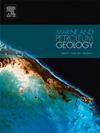Geochemical characteristics of light hydrocarbons generated in thermochemical sulfate reduction: Results from three series of simulation experiments
IF 3.7
2区 地球科学
Q1 GEOSCIENCES, MULTIDISCIPLINARY
引用次数: 0
Abstract
Thermochemical sulfate reduction (TSR) is an intense redox reaction that significantly alters the original hydrocarbons in deep reservoirs. Previous studies have shown that light hydrocarbons (LHs) could be generated as important products in certain stages of TSR. However, the geochemical characteristics of these TSR-derived LHs remain poorly investigated, and their differences from those of LHs generated by thermal cracking (TC-derived LHs) are unclear. A TSR simulation designed to generate LHs without the influence of TC can solve this problem. In this study, three TSR series were conducted using n-octadecane, n-dodecylbenzene, and heavy oil as initial hydrocarbon reactants in sealed gold tubes. The yield, molecular composition, and carbon isotopic characteristics of the generated LHs were systematically analyzed. Results indicated that the yield of TSR-derived light oils was considerable (243.90–326.48 mg/g HCs), broadly equivalent to that in TC. However, the generation process of TSR-derived LHs was significantly brought forward and occurred at lower maturities relative to TC. In terms of molecular composition, TSR facilitated the formation of n-alkanes and aromatics, while suppressing the generation of branched alkanes and cycloalkanes. This resulted in the compositional characteristics of TSR-derived LHs being distinct from those of TC-derived LHs. Additionally, TSR-derived LHs became increasingly enriched in 13C as TSR progressed. The observed enrichment (3.7 ‰–6.2 ‰) was greater than that in TC-derived LHs (<3 ‰) but smaller than that in TSR-altered LHs, most of which were destroyed by TSR alteration (3–22 ‰). Most geochemical parameters of TSR-derived LHs did not provide reliable information on biological inputs, depositional environment, maturity, or later alteration. As a result, these parameters should be used cautiously in deep reservoirs where TSR is likely to occur. Moreover, the composition of the initial hydrocarbons influenced the generation of TSR-derived LHs. The long-chain paraffin group from the initial hydrocarbons breaks off and gradually evolves into LHs during the later stages of TSR, whereas the occurrence of aromatic rings leads to the earlier generation of aromatic-rich LHs. TSR-derived light oils represent a new hydrocarbon resource in deep basins, although they are less economical than TSR-unaltered oils. This study enhances our understanding of the generation, evolution, and typical geochemical characteristics of TSR-derived LHs, and offers valuable insights for evaluating light oil resources in deep basins.
求助全文
约1分钟内获得全文
求助全文
来源期刊

Marine and Petroleum Geology
地学-地球科学综合
CiteScore
8.80
自引率
14.30%
发文量
475
审稿时长
63 days
期刊介绍:
Marine and Petroleum Geology is the pre-eminent international forum for the exchange of multidisciplinary concepts, interpretations and techniques for all concerned with marine and petroleum geology in industry, government and academia. Rapid bimonthly publication allows early communications of papers or short communications to the geoscience community.
Marine and Petroleum Geology is essential reading for geologists, geophysicists and explorationists in industry, government and academia working in the following areas: marine geology; basin analysis and evaluation; organic geochemistry; reserve/resource estimation; seismic stratigraphy; thermal models of basic evolution; sedimentary geology; continental margins; geophysical interpretation; structural geology/tectonics; formation evaluation techniques; well logging.
 求助内容:
求助内容: 应助结果提醒方式:
应助结果提醒方式:


